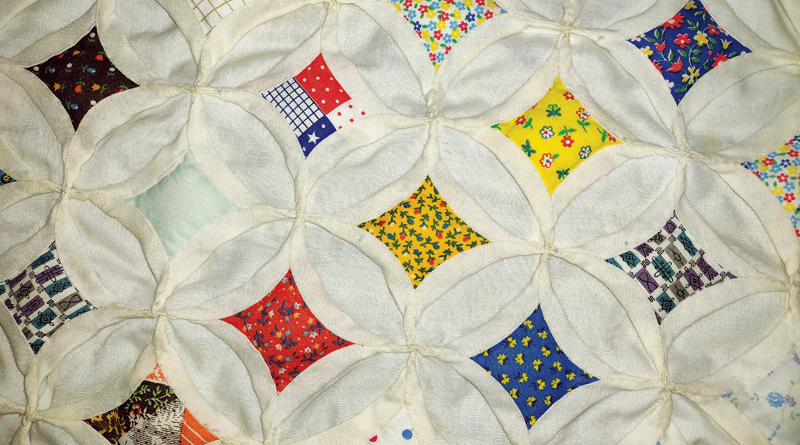What Grandma Said… ~ Around The Frame

Back in early February, I purchased a beautiful cathedral window quilt that I proceeded to list in my Born Again Quilts Etsy shop. This cathedral window quilt was made in the 1970s with vibrant scraps of many bright purple, pink, orange, and yellow floral fabrics as well as novelty fabrics and calicoes from the Bicentennial Quilt Revival era. When it came down to pricing it, I searched Etsy for other 1970 cathedral window quilts to see what other sellers had priced their quilts. My search popped up several results and just looking at the photos, I saw one that looked bright like mine. The shop name had the word “quilt” in its title, so I assumed it’s being sold by another seller who specializes in quilts.
Opening the listing, I was shocked to read that a highlight is that the quilt was made in the 1920s! I was thinking, how can this seller be off fifty years in dating this quilt? I sent the seller a message and asked them how they determined the quilt’s age. The seller responded, “The lady that I acquired it from shared that her grandmother had made it in the early 1900’s which is what I put in the listing. She could have been mistaken, but I felt like she was a reliable source.” WOW! In other words, Grandma Walton wore clothes of the same color palette as Mrs. Forman of “That 70’s Show”: Who knew? I wrote to the seller back that the seller’s grandmother must have time-traveled to the 1970s to acquire the fabrics to time-travel back to create it in the 1920s! I then proceeded to recommend resources on dating fabrics so she could look at quilts and more accurately determine the age rather than depending on what grandma said. The seller thanked me for the information and stated it was never her intention to mislead anyone. The listing was revised to read the fabrics appear to be from the 1970s and highlighted to the 1930s.
There are many ways to date quilts that do not depend on what grandma said. You can examine the quilt to see if there is a date penned or embroidered on it. You need to discern, though, whether the date was done at the time the quilt was finished or added years later. You can go online to quilt indexes like the one at the International Quilt Museum and search for quilts of different ages and view them to find ones with similar colors to the one you are researching. Fabric colors and fiber content, quilt techniques, whether a quilt is bordered, binding technique, and quilt width can all aid in determining a quilt’s age. I have dated quilts where grandma’s birth-death dates do not line up with her being the maker of a family quilt.
My cathedral window quilt was priced at $220 and sold two days after I listed it. This one was listed for a couple hundred dollars more than mine. I wondered if now knowing that the age was 50 years off if the price would reflect its age. Initially it did not, but over the course of the past few months the price has dropped to only a bit higher than mine. Apparently, people aren’t interested in paying so much for a 1970s quilt as for a 1920s quilt.
Just as a word of caution that just because grandma said so, doesn’t mean it is so!
Shucked Update: If you didn’t catch the WANE – TV segment of the Hired Man’s quilt top now in the nine-time Tony nominated Musical Shucked go to: rb.gy/veqnf
Lois Levihn is the owner of Born Again Quilts. If you have a textile story to share you can contact her at (260) 515-9446 or bornagainquilts@frontier.com.
- The Stars & Stripes Are Forever: Around The Frame - July 5, 2024
- Sam Butcher: A Life Filled With Precious Moments ~ Around The Frame - June 7, 2024
- Aunt Dora & Her Well-Lived Life ~ Around The Frame - May 10, 2024


